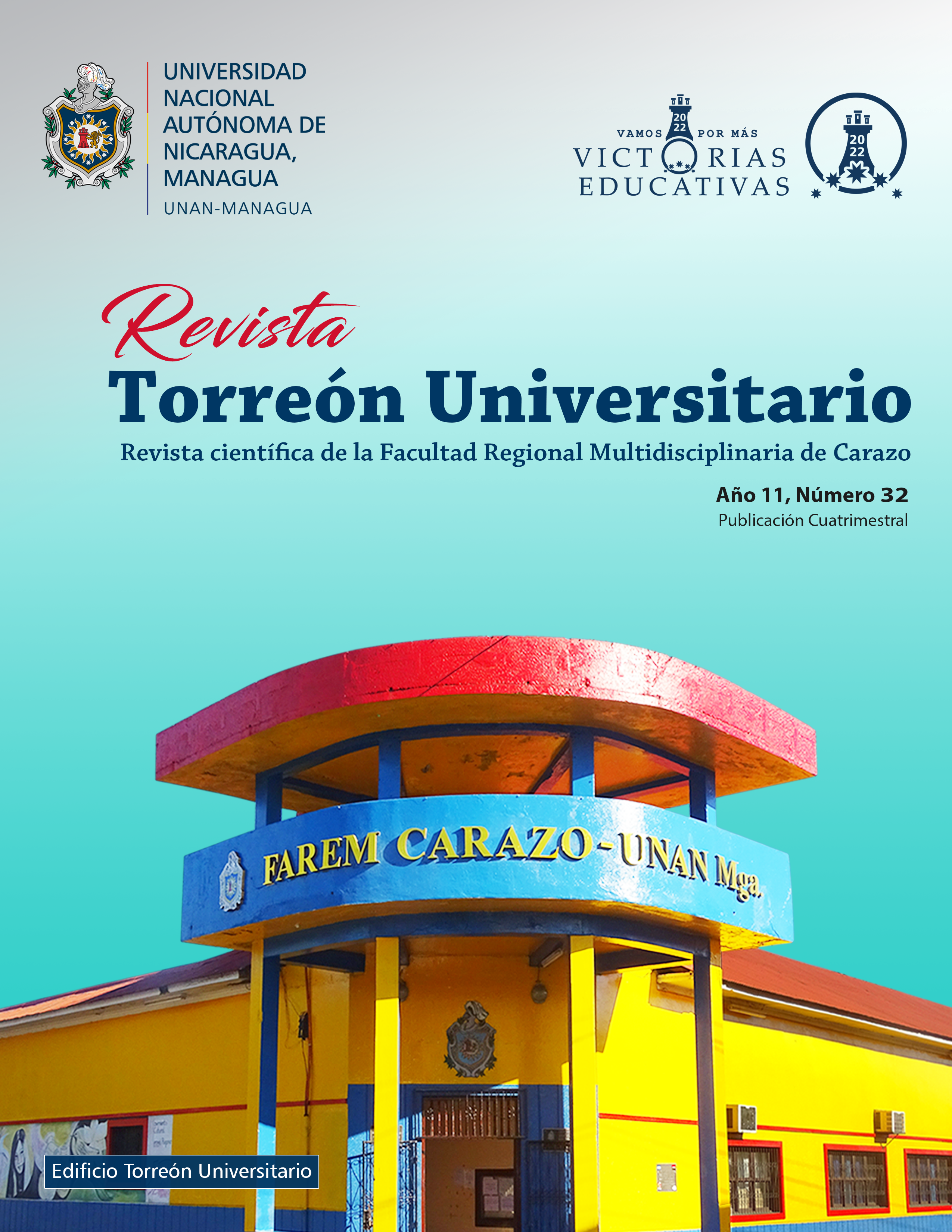Bacterial bioprospecting in sediment from the Chiquito River, in León, Nicaragua during dry and rainy seasons.
DOI:
https://doi.org/10.5377/rtu.v11i32.15034Keywords:
Bioprospecting, heavy metals, sedimentsAbstract
Two sample collection (dry and rainy season) were carried out in sediments exposed to tannery effluents and domestic wastewater (Exposed Sample); and in sediment visually contaminated by domestic wastewater (Reference Sample), with the aim of isolating and identifying bacteria according to Gram (structural) and concentrations of heavy metals of interest. The highest percentage of colonies found was in the exposed sediment, in the rainy season (66.67), identified as Gram- and the lowest was 33.33 in the same season, corresponding to Gram+. The highest enzymatic activity of lipase was in the MR in summer (3219 µg of Pnpg/10 min) and the lowest activity was obtained in the ME in winter (1710.6 µg of Pnp/g.10 min). The variation of aqueous pH and moisture content was not significant at both sites, both in the dry and rainy seasons. Hexavalent Chromium and Arsenic were not detected during the sampling periods. The texture of the sediment is sandy, which probably facilitates the transport of heavy metals. Iron concentration was similar in summer and winter, in the MR and ME (36.416 and 36.428 g.Kg -1 respectively). Lead concentrations were 12, 12,242 and 22 mg.kg-1, at the MR winter, MR summer and ME summer points, respectively; in the ME in winter it was not detected. The results suggest that, due to microbial interaction with metals, they have created resistance and tolerance through different mechanisms. It is necessary to know the minimum inhibitory concentrations of the isolated bacteria and to enhance their application in Bioremediation.
Downloads
References
Alvarado, E. O. (2019). Impacto de las actividades antropogénicas de la ciudad de León sobre la calidad del sedimento del Río Chiquito, Mayo 2016 – Enero 2017. Monografía para optar al título de Licenciatura en Química Ambiental. Obtenido de https://repositorio.unan.edu.ni/14312/
Aquiahualt Ramos, M. d., Sepúlveda, T. V., Prado Barragán, L. A., Shiraí Matsumoto, K., Ramírez Vives, F., & Salazar González, M. (2012). Manual de prácticas de laboratorio. Microbiología general.
Cubillo, F. J. (2018). Contaminantes y aprovechamiento de desechos en curtidoras de León, producir biogás y biodiesel. Revista Iberoamericana de Bioeconomia y Cambio Climático, 4(8), 954-964. doi:10.5377/ribcc. v4i8.6675
Ehrlich, H. L. (1999). Microbes as geologic agents: their role in mineral formation. Journal Geomicrobiol, 16, 135-153.
Emerson, D. (2000). Microbial oxidation of Fe(II) and Mn(II) at circumneutral pH. Environmental Metal–Microbe Interactions., 31-52.
Espitia, N. (2014). Determinación de metales pesados en sedimentos superficiales en cuerpos de agua del canal del dique en las poblaciones de Gambote y Soplavientos (Bolívar). Revista del Instituto de Investigación (RIIGEO), FIGMMG-UNMSM, 17(34), 91-100.
Leboffe, M. J., & Pierce, B. E. (2011). A Photographic Atlas for the Microbiology Laboratory.
Li, C., Quan, Q., Gan, Y., Dong, J., Fang, J., Wang, L., & Liu, J. (2020). Effects of heavy metals on microbial communities in sediments and establishment of bioindicators based on microbial taxa and function for environmental monitoring and management. Science of the Total Environment, 749.
Marrero Coto, J., Díaz Valdivia, A., & Coto Pérez, O. (2010). Mecanismos moleculares de resistencia a metales pesados en las bacterias y sus aplicaciones en la biorremediación. CENIC Ciencias Biológicas, 41(1), 67-78.
Páramo Aguilera, L. A., Delgado Silva, H. D., & Ríos Guevara, C. K. (2021). Potencial del laboratorio de biotecnología del PIESA-UNI para desarrollar bioprocesos ambientales, agrícolas e industriales. Nexo, 34(02), 534-546. Obtenido de https://doi.org/10.5377/nexo.v34i02.11540
Pucurrul, F. (2016). Expresión heteróloga de una posible manganeso oxidasa bacteriana de origen antártico. Trabajo de Grado, Licenciatura en Bioquímica.
Shao, Z., & Sun, F. (2007). Intracellular sequestration of manganese and phosphorus in a metal-resistant fungus Cladosporium cladosporioides from deep-sea sediment. Extremophiles, 11, 435-443. doi:10.1007/s00792-006-0051-0
Smets, B. F., Morrow, J. B., & Arango Pinedo, C. (2003). Plasmid Introduction in Metal-Stressed, Subsurface-Derived Microcosms: Plasmid Fate and Community Response. Applied and Environmental Microbiology, 69(7), 4087-4097.
Sobolev, D., & Begonia T, M. F. (2008). Effects of Heavy Metal Contamination upon Soil Microbes: Lead-induced Changes in General and Denitrifying Microbial Communities as Evidenced by Molecular Markers. Environmental Research and Public Health, 5(5), 450-456.
Published
How to Cite
Issue
Section
License
Copyright (c) 2022 National Autonomous University of Nicaragua, Managua.

This work is licensed under a Creative Commons Attribution-NonCommercial-NoDerivatives 4.0 International License.
Los autores que publican en esta revista están de acuerdo con los siguientes términos.
- El autor o los autores de los artículos, ensayos o investigaciones conceden a la Universidad Nacional Autónoma de Nicaragua, Managua (UNAN-Managua) los derechos de edición (copyright) del trabajo enviado, por consiguiente la Universidad cuenta con el derecho exclusivo para publicar el artículo durante el periodo completo de los derechos de autor.
- Estos derechos de autor/ autores autorizan a la Revista Torreón Universitario y a la Universidad editar y divulgar/publicar el artículo en dicha Revista, incluyendo reproducción impresa y electrónica, el almacenamiento, recuperación y cualquier otro tipo de publicación, y fuentes de información secundaria como servicios de resúmenes y bases de datos, así mismo la facultan a proteger el artículo contra el uso no autorizado para su difusión por medios impresos o electrónicos (PDF, HTML, EPUB, XML u otros).
Licencia para el uso del contenido
La revista hace uso de la Licencia Creative Commons Atribución-NoComercial-SinDerivar 4.0 Internacional.
Bajo esta declaración:

Este revista está sujeta a una licencia de Creative Commons Reconocimiento-NoComercial-SinObraDerivada 4.0 Internacional. Puede ser copiada, distribuida y transmitida públicamente siempre y cuando se cite al autor y la fuente (Revista Torreón Universitario), no debe modificarse ni utilizarse con ningún fin comercial. La licencia completa se puede consultar en http://creativecommons.org/licenses/by-nc-nd/4.0/.

